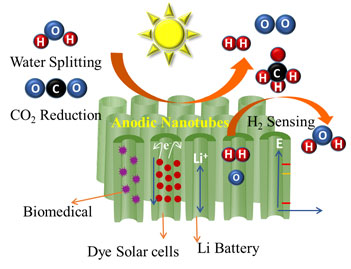Crossref Citations
This article has been cited by the following publications. This list is generated based on data provided by Crossref.
Mohamed, M. Sheikh
Torabi, Aida
Paulose, Maggie
Kumar, D. Sakthi
and
Varghese, Oomman K.
2017.
Anodically Grown Titania Nanotube Induced Cytotoxicity has Genotoxic Origins.
Scientific Reports,
Vol. 7,
Issue. 1,
Alves, Sofia A.
Rossi, André L.
Ribeiro, Ana R.
Werckmann, Jacques
Celis, Jean-Pierre
Rocha, Luís A.
and
Shokuhfar, Tolou
2017.
A first insight on the bio-functionalization mechanisms of TiO2 nanotubes with calcium, phosphorous and zinc by reverse polarization anodization.
Surface and Coatings Technology,
Vol. 324,
Issue. ,
p.
153.
Fedorov, Fedor
Vasilkov, Michail
Lashkov, Andrey
Varezhnikov, Alexey
Fuchs, Dirk
Kübel, Christian
Bruns, Michael
Sommer, Martin
and
Sysoev, Victor
2017.
Toward new gas-analytical multisensor chips based on titanium oxide nanotube array.
Scientific Reports,
Vol. 7,
Issue. 1,
Puthirath Balan, Aravind
Radhakrishnan, Sruthi
Neupane, Ram
Yazdi, Sadegh
Deng, Liangzi
A. de los Reyes, Carlos
Apte, Amey
B. Puthirath, Anand
Rao, B. Manmadha
Paulose, Maggie
Vajtai, Robert
Chu, Ching-Wu
Martí, Angel A.
Varghese, Oomman K
Tiwary, Chandra Sekhar
Anantharaman, M. R.
and
Ajayan, Pulickel M
2018.
Magnetic Properties and Photocatalytic Applications of 2D Sheets of Nonlayered Manganese Telluride by Liquid Exfoliation.
ACS Applied Nano Materials,
Vol. 1,
Issue. 11,
p.
6427.
Puthirath Balan, Aravind
Radhakrishnan, Sruthi
Kumar, Ritesh
Neupane, Ram
Sinha, Shyam Kanta
Deng, Liangzi
de los Reyes, Carlos A.
Apte, Amey
Rao, B. Manmadha
Paulose, Maggie
Vajtai, Robert
Chu, Ching Wu
Costin, Gelu
Martí, Angel A.
Varghese, Oomman K.
Singh, Abhishek K.
Tiwary, Chandra Sekhar
Anantharaman, Maliemadom R.
and
Ajayan, Pulickel M.
2018.
A Non-van der Waals Two-Dimensional Material from Natural Titanium Mineral Ore Ilmenite.
Chemistry of Materials,
Vol. 30,
Issue. 17,
p.
5923.
Balaji, U.
and
Pradhan, S.K.
2018.
Titanium anodisation designed for surface colouration - Systemisation of parametric interaction using response surface methodology.
Materials & Design,
Vol. 139,
Issue. ,
p.
409.
Puthirath Balan, Aravind
Radhakrishnan, Sruthi
Woellner, Cristiano F.
Sinha, Shyam K.
Deng, Liangzi
Reyes, Carlos de los
Rao, Banki Manmadha
Paulose, Maggie
Neupane, Ram
Apte, Amey
Kochat, Vidya
Vajtai, Robert
Harutyunyan, Avetik R.
Chu, Ching-Wu
Costin, Gelu
Galvao, Douglas S.
Martí, Angel A.
van Aken, Peter A.
Varghese, Oomman K.
Tiwary, Chandra Sekhar
Malie Madom Ramaswamy Iyer, Anantharaman
and
Ajayan, Pulickel M.
2018.
Exfoliation of a non-van der Waals material from iron ore hematite.
Nature Nanotechnology,
Vol. 13,
Issue. 7,
p.
602.
Fuentes, Elena
Alves, Sofia
López-Ortega, Ainara
Mendizabal, Lucía
and
Sáenz de Viteri, Virginia
2019.
Biomaterial-supported Tissue Reconstruction or Regeneration.
Radhakrishnan, Sruthi
Park, Jun Hyoung
Neupane, Ram
de los Reyes, Carlos A.
Sudeep, Parambath M.
Paulose, Maggie
Martí, Angel A.
Tiwary, Chandra Sekhar
Khabashesku, Valery N.
Varghese, Oomman K.
Kaipparettu, Benny Abraham
and
Ajayan, Pulickel M.
2019.
Fluorinated Boron Nitride Quantum Dots: A New 0D Material for Energy Conversion and Detection of Cellular Metabolism.
Particle & Particle Systems Characterization,
Vol. 36,
Issue. 2,
Rahayu, S S
Budiarti, V S A
Sumiyarso, B
Amrul, A
and
Triyono, E
2019.
Application of waste water treatment technology from exhaust electroplating and anodizing process using electro-coagulation method.
Journal of Physics: Conference Series,
Vol. 1217,
Issue. 1,
p.
012002.
Sheng, Xia
Xu, Tao
and
Feng, Xinjian
2019.
Rational Design of Photoelectrodes with Rapid Charge Transport for Photoelectrochemical Applications.
Advanced Materials,
Vol. 31,
Issue. 11,
Larbi, Tarek
El‐Kelany, Khaled E.
Doll, Klaus
and
Amlouk, Mosbah
2020.
Efficient ab initio quantum mechanical simulations of structural stability and vibrational properties of bulk, monolayer and (n,0) nanotubes: Yttrium sesquioxide Y2O3.
Journal of Raman Spectroscopy,
Vol. 51,
Issue. 2,
p.
232.
Xue, Yudong
and
Wang, Yunting
2020.
A review of the α-Fe2O3 (hematite) nanotube structure: recent advances in synthesis, characterization, and applications.
Nanoscale,
Vol. 12,
Issue. 20,
p.
10912.
Apolinário, Arlete
Sousa, Célia T.
Oliveira, Gonçalo N. P.
Lopes, Armandina M. L.
Ventura, João
Andrade, Luísa
Mendes, Adélio
and
Araújo, João P.
2020.
Tailoring the Anodic Hafnium Oxide Morphology Using Different Organic Solvent Electrolytes.
Nanomaterials,
Vol. 10,
Issue. 2,
p.
382.
Zhang, Tao
Paulose, Maggie
Neupane, Ram
Schaffer, Lilly A.
Rana, Dhan B.
Su, Jinzhan
Guo, Liejin
and
Varghese, Oomman K.
2020.
Nanoporous WO3 films synthesized by tuning anodization conditions for photoelectrochemical water oxidation.
Solar Energy Materials and Solar Cells,
Vol. 209,
Issue. ,
p.
110472.
Bellè, Umberto
Pelizzari, Filippo
Lucotti, Andrea
Castiglioni, Chiara
Ormellese, Marco
Pedeferri, MariaPia
and
Diamanti, Maria Vittoria
2020.
Immobilized Nano-TiO2 Photocatalysts for the Degradation of Three Organic Dyes in Single and Multi-Dye Solutions.
Coatings,
Vol. 10,
Issue. 10,
p.
919.
Adeleye, Aderemi Timothy
John, Kingsley I.
Adeleye, Promise Goodness
Akande, Amos Adeleke
and
Banjoko, Oluwakemi Oluwabunmi
2021.
One-dimensional titanate nanotube materials: heterogeneous solid catalysts for sustainable synthesis of biofuel precursors/value-added chemicals—a review.
Journal of Materials Science,
Vol. 56,
Issue. 33,
p.
18391.
Dalmis, Ramazan
Yılmaz, Ozan
and
Dikici, Tuncay
2021.
A new concept for the eco-friendly structural colorization of anodic titania: Photonic crystal structure.
Colloids and Surfaces A: Physicochemical and Engineering Aspects,
Vol. 631,
Issue. ,
p.
127748.
de Brito, Juliana Ferreira
and
Mascaro, Lucia Helena
2021.
Enhancement of photocurrent response for self-ordered Nb2O5 nanotubes synthesized at room temperature.
Journal of Materials Science,
Vol. 56,
Issue. 3,
p.
2088.
Cao, Wangzhu
Chen, Kunfeng
and
Xue, Dongfeng
2021.
Highly Ordered TiO2 Nanotube Arrays with Engineered Electrochemical Energy Storage Performances.
Materials,
Vol. 14,
Issue. 3,
p.
510.



